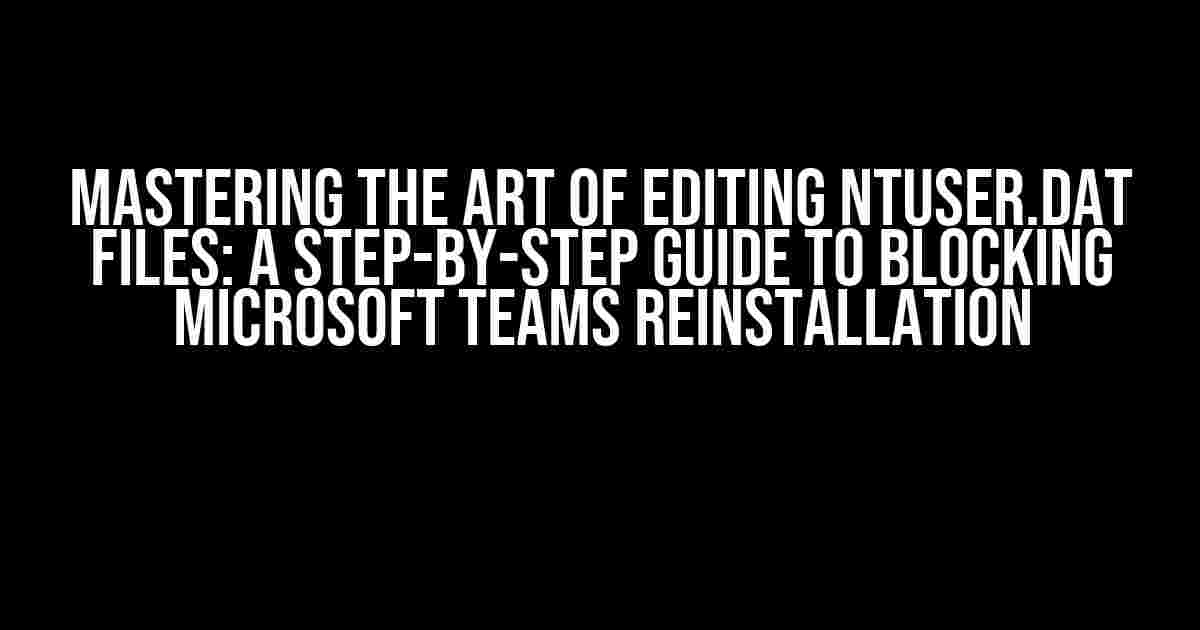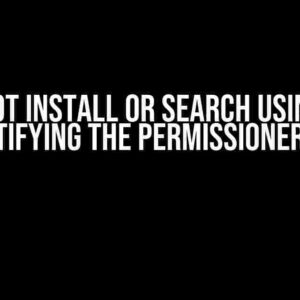Are you tired of Microsoft Teams constantly reinstalling itself on your system, taking up valuable resources and driving you crazy? Do you want to take control of your Windows registry and prevent this annoyance once and for all? Look no further! In this comprehensive guide, we’ll dive deep into the world of NTUSER.DAT files and show you exactly how to edit them to insert a new registry key, effectively blocking Microsoft Teams reinstallation. Buckle up, because we’re about to get our hands dirty!
- Understanding NTUSER.DAT Files: The Basics
- Preparation is Key: Backup and Safety Precautions
- Step 1: Obtain the NTUSER.DAT File
- Step 2: Open the NTUSER.DAT File in a Hex Editor
- Step 3: Find the Registry Key
- Step 4: Insert a New Registry Key
- Step 5: Save the Changes
- Step 6: Replace the Original NTUSER.DAT File
- Conclusion
- Troubleshooting and Best Practices
Understanding NTUSER.DAT Files: The Basics
Before we dive into the editing process, it’s essential to understand what NTUSER.DAT files are and their role in the Windows operating system. NTUSER.DAT is a file that stores user-specific registry settings, including user preferences, application settings, and more. Each user account on a Windows system has its own NTUSER.DAT file, which is located in the %UserProfile%\ntuser.dat directory.
This file is crucial for maintaining user-specific settings, and editing it requires caution and precision. So, if you’re new to registry editing, make sure you understand the risks involved and take necessary precautions to avoid damaging your system.
Preparation is Key: Backup and Safety Precautions
Before editing the NTUSER.DAT file, it’s essential to take a full backup of your system and registry. This will ensure that you can revert to a previous state in case something goes wrong. Use a reliable backup software to create a system image and store it in a safe location.
In addition to backing up your system, make sure you have administrative privileges and are comfortable working with the Windows registry. If you’re unsure about any step in this process, consider seeking guidance from a qualified IT professional.
Step 1: Obtain the NTUSER.DAT File
To edit the NTUSER.DAT file, you’ll need to obtain it from the user profile directory. Follow these steps:
- Open File Explorer and navigate to the
%UserProfile%directory (usually located atC:\Users\). - Locate the
ntuser.datfile and copy it to a safe location on your system, such as the desktop or documents folder. - Make sure to copy the file, rather than moving it, to avoid disrupting your system.
Step 2: Open the NTUSER.DAT File in a Hex Editor
To edit the NTUSER.DAT file, you’ll need a hex editor software. There are many free and paid options available, including HxD, Hex Workshop, and more. For this guide, we’ll use HxD, a free and popular hex editor.
Download and install HxD, then follow these steps:
- Open HxD and select
File>Opento open the copied NTUSER.DAT file. - In the
Opendialog box, selectAll Files (*.*)as the file type, and navigate to the location where you copied the NTUSER.DAT file. - Select the file and click
Open.
Step 3: Find the Registry Key
Once the NTUSER.DAT file is open in HxD, you’ll need to find the registry key related to Microsoft Teams. Follow these steps:
- In the HxD interface, navigate to the
Searchmenu and selectFind. - In the
Finddialog box, enter the following string:SOFTWARE\Microsoft\Office\Teams. - Click
Find Nextto locate the registry key. - When you find the key, you’ll see a series of hexadecimal values and strings. Take note of the starting address of the key, as you’ll need it later.
Step 4: Insert a New Registry Key
To block Microsoft Teams reinstallation, you’ll need to insert a new registry key that prevents the software from reinstalling itself. Follow these steps:
- In the HxD interface, navigate to the
Editmenu and selectInsert Hex Values. - In the
Insert Hex Valuesdialog box, enter the following hexadecimal values:
43 00 3A 00 5C 00 50 00 72 00 6F 00 67 00 72 00 61 00 6D 00 44 00 61 00 74 00 61 00 5C 00 4D 00 69 00 63 00 72 00 6F 00 73 00 6F 00 66 00 74 00 5C 00 4F 00 66 00 66 00 69 00 63 00 65 00 5C 00 54 00 65 00 61 00 6D 00 73 00 5C 00 44 00 69 00 73 00 61 00 62 00 6C 00 65 00 54 00 65 00 61 00 6D 00 73 00 00 00
This will create a new registry key that blocks Microsoft Teams reinstallation.
Step 5: Save the Changes
Once you’ve inserted the new registry key, save the changes to the NTUSER.DAT file:
- In the HxD interface, navigate to the
Filemenu and selectSave As. - In the
Save Asdialog box, navigate to the original location of the NTUSER.DAT file (%UserProfile%\ntuser.dat). - Select the file and click
Save.
Step 6: Replace the Original NTUSER.DAT File
Finally, replace the original NTUSER.DAT file with the edited version:
- Copy the edited NTUSER.DAT file from the safe location where you saved it.
- Navigate to the original location of the NTUSER.DAT file (
%UserProfile%\ntuser.dat). - Delete the original file and paste the edited version in its place.
Conclusion
Congratulations! You’ve successfully edited the NTUSER.DAT file to block Microsoft Teams reinstallation. This process may seem daunting, but with patience and attention to detail, you can master the art of registry editing.
Remember to always exercise caution when working with the registry, and make sure to take regular backups to ensure your system’s stability.
Troubleshooting and Best Practices
If you encounter issues after editing the NTUSER.DAT file, try the following troubleshooting steps:
- Restore the original NTUSER.DAT file from your backup.
- Re-register the Microsoft Teams software using the built-in
Teams.exeexecutable. - Consult Microsoft’s official documentation for troubleshooting Microsoft Teams installation issues.
Best practices for registry editing include:
- Making regular backups of your system and registry.
- Working in a isolated environment before applying changes to your production system.
- Testing changes in a controlled environment before deploying them widely.
| Hex Editor Software | Free/Paid | Popular Features |
|---|---|---|
| HxD | Free | Search and replace, insert hex values, data inspector |
| Hex Workshop | Paid | Advanced search, data comparison, checksum calculator |
| XVI32 | Free | Search and replace, insert hex values, data analyzer |
By following these steps and best practices, you’ll be well on your way to mastering the art of NTUSER.DAT file editing and taking control of your Windows registry.
Remember, with great power comes great responsibility. Edit your registry with care, and always keep a backup handy.
Frequently Asked Question
Get ready to dive into the world of registry editing and learn how to prevent Microsoft Teams reinstallation for a specific user!
What is the NTUSER.DAT file, and why do I need to edit it?
The NTUSER.DAT file is a registry file specific to each Windows user profile. It stores user-specific settings and preferences. Editing this file allows you to insert a new registry key that prevents Microsoft Teams reinstallation for that particular user. Think of it as a custom setting that overrides the default behavior!
How do I access and edit the NTUSER.DAT file?
To access the NTUSER.DAT file, navigate to the C:\Users\
What is the exact registry key I need to add to prevent Microsoft Teams reinstallation?
You’ll need to add a new key called “DisableMicrosoftTeams” with a value of “1” under the HKEY_CURRENT_USER\SOFTWARE\Policies\Microsoft\Office\16.0\common\ dword registry key. This key will prevent Microsoft Teams from reinstalling itself for the specific user. Make sure to create the key and value correctly to avoid any errors!
Are there any potential risks or side effects of editing the NTUSER.DAT file?
Yes, editing the NTUSER.DAT file can be risky if not done correctly. Improper changes can corrupt the registry, leading to system instability or even preventing the user from logging in. Make sure to create a backup of the original file and be cautious when making changes. If you’re unsure, consider seeking guidance from a Windows expert or IT professional!
Will this method prevent Microsoft Teams reinstallation for all users on the system?
No, this method only applies to the specific user whose NTUSER.DAT file you edited. If you want to prevent Microsoft Teams reinstallation for all users, you’ll need to edit the corresponding registry key for each user or use a different approach, such as a Group Policy Object (GPO) or a system-wide registry modification. Think of it as a customized solution for each user!



